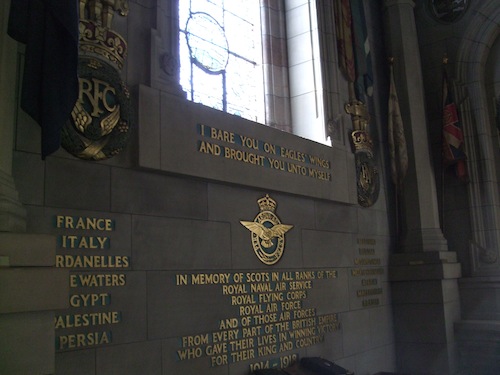 Even as a teenager and then later as a visitor at the Scottish National War Museum atop Edinburgh Castle (see photo), I found the combination of honoring soldiers and the Christian faith, or at least belief in God, to be shocking. Yet this time, for the first time, I had the opportunity to make an official visit and look closely at the inscriptions and photos. Addi-tionally, in the meantime I have acquired a knowledge of the sociology of religion, and with it the opportunity to compare how heroes are honored in other countries, cultures, and religions.
Even as a teenager and then later as a visitor at the Scottish National War Museum atop Edinburgh Castle (see photo), I found the combination of honoring soldiers and the Christian faith, or at least belief in God, to be shocking. Yet this time, for the first time, I had the opportunity to make an official visit and look closely at the inscriptions and photos. Addi-tionally, in the meantime I have acquired a knowledge of the sociology of religion, and with it the opportunity to compare how heroes are honored in other countries, cultures, and religions.
Now I also know that the belief that soldiers have died for God, that they will be re-warded as martyrs for good works, and that they will go to be with him is not a typical Scottish or British affair. Rather, it is something that is found worldwide regardless of re-ligion. Furthermore, at one time it was something that was the order of the day in all European countries. In Germany, inscriptions on innumerable and in the meantime occa-sionally overgrown and seldom cared for memorials and memorial stones for soldiers who fell in World War I are witnesses to this fact.
At the highest point of the hill upon which Edinburgh Castle stands, this phenomenon is very much alive. For those fellow countrymen with a connection to the memorial, it incites religious feelings. And a number of the reminders and inscriptions date from more recent times. The huge complex was opened in 1927 (see photo), deals mostly with World War II, and has as its most recent extension a memorial (better said, a chapel) that was added in 2003.
Just so that no one misunderstands me: The war against National Socialist Germany was largely a just cause. Also, as a German I thank all those countries whose citizens died so that Germany could be freed from Nazi dictatorship and that I can live in a Germany that is now free. However, the elevation of a just war to a type of religious war in the name of God, and the assertion that those who died would automatically find themselves in God’s presence – by the way, regardless of the faith to which they adhered – has to be rejected by Christian ethics.
Now to some details:
The large inscription in the west wing “Whether their fame centuries long should ring, They cared not overmuch, But they cared greatly to serve God and the King” (Henry Newbolt) or the Celtic inscription in the east chapel for the Scottish Corps: “My country, my honour, my God” (and under it a Celtic cross) may be dismissed as harmless and “God and king” looked at as an empty phrase. The shrines, angels, and religious symbols can also be booked under a rather general and diffuse religiosity; experts would tend to speak of a ‘civil religion.‘
Still, in the large chapel around the so-called ‘shrine’ there are angels who are wearing the coat of arms. The very large writing on the inner circumference of the chapel quotes from Wisdom 3:1+3 in the so-called Apocrypha: “The souls of the righteous are in the hand of God. There shall no evil happen to them. They are in peace” (see photo).
Unknown soldiers are honored with an allusion to the book of life referred to in the New Testament (Revelation 20:12, and often): “Others also there are who perished un-known; their sacrifice is not forgotten, and their names, though lost to us, are written in the Books of God (see photo). Four kneeling and praying angels (see photo) and the arch-angel Michael hanging from the ceiling (see Revelation 12:7-8) complete the religious ori-entation toward Christianity.
God is directly exploited when God in the first person says the following for the benefit of the Royal Air Force in the Hall of Honour: “I bare you on eagles’ wings and brought you unto myself,“ which is taken from Exodus 19:4 (see photo).
Still one more example is the comment in the guide which appeared in 2004 regarding a statue in the east chapel: “A statue in bronze, partly overlaid with gold and silver, with a background of carved and painted stone showing the rising sun, the land and the sea (Earth, Air, Fire and Water). The symbolic figure represents the Soul rising purified from the Flames of Sacrifice, the left hand grasps the broken blade – the end of war – and the right hand raises the hilt – now the Cross Triumphant – while the eyes seem to gaze be-yond the range of mortal vision and to find there ‚A new Heaven and a new Earth‘ (Reve-lation, xxi 1)“ Scottish National War Memorial: Official Guide. Norwich: Jarrold Publ., 2004. p. 26) (see photo).
Oh man, oh man, as if nothing had happened, the sword is made into a triumphant cross and secures the new heavens and the new earth for the army. Soldiers who have died can reckon with the fact that they will be rewarded by God for their sacrifice?! Have we learned nothing from history?





